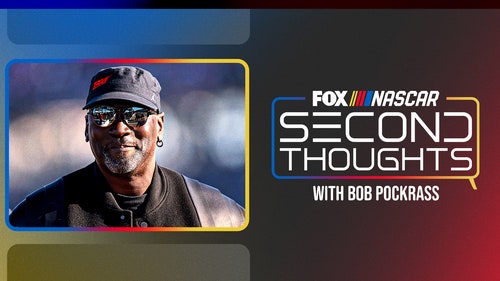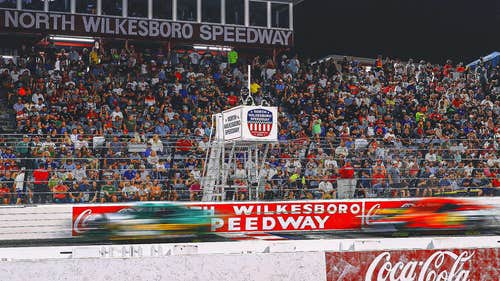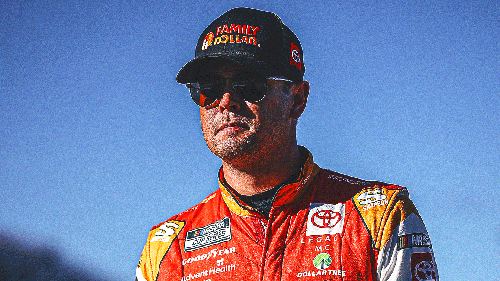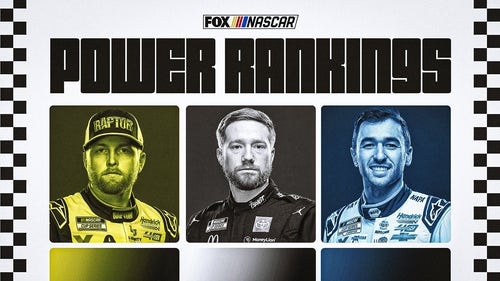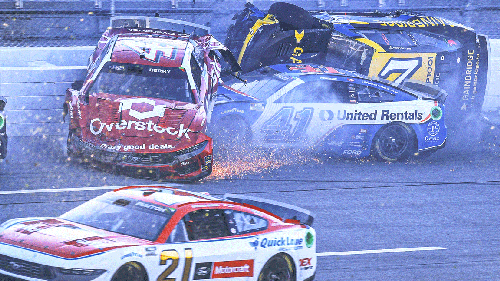
How To Fall In Love With NASCAR
I’ve never been in a spaceship as it takes off, but I imagine it feels like forty 750-horsepower engines starting at the same time before a NASCAR race.
I felt them in the stands of the first race I ever went to at Bristol Motor Speedway. The slow rumble turned into a monstrous roar that pumped adrenaline into the tips of my fingers and made me think there was a good chance I could run through a brick wall if I tried.
I had never been to a NASCAR race until a few years ago, and I was completely clueless going in. Most of my knowledge came from watching Talladega Nights in high school, which is to say that I had none.
But when I immersed myself in the world, I found a sport far more tactical and physical than I ever imagined. The races hooked me based on my intense physical reaction, but they kept my attention on TV because of their exciting finishes, rich history, and a whole lot of action.
Most sports haven’t returned yet due to coronavirus, but NASCAR came roaring back last weekend, and fans have been blessed with four races in six days. Many people tuning in haven’t seen races before, so I thought — as someone who used to know as little as some of you probably do now — that I’d tell you what I found most interesting and surprising when I began watching.
The more you know, the more interesting it is, so buckle up and start your engines. Here we go.
The unexpected
Shock and awe are two of the best things about any sport, right? The idea that you have no idea what’s going to happen until it does? The race at Darlington on Wednesday was filled with the unexpected — Denny Hamlin took a risk by not pitting his car during a caution with 34 laps to go.
A caution means the race is essentially paused: when anything makes racing conditions unsafe — a crash, debris on the track, rain — drivers continue around the track slowly, but they can’t jockey for positions. They do lose their spot, however, if they pull into the pits for tire changes, which drivers have to do so that their cars don’t literally fall apart.
Hamlin chose to push the limits and stay out in front. It paid off: the race was called with 29 laps to go, and Hamlin notched his second win of the year after the Daytona 500. The only other driver with two wins this season so far is Joey Logano.
Kyle Busch spun Chase Elliott into the wall when he “misjudged” (his words) the gap between Elliott and Kevin Harvick’s cars. Elliott had to pull into the pits, and he gave Busch the middle finger the next time Busch came around. Busch, a notorious heel on the circuit, later said it wasn’t intentional.
Man, I love pettiness in sports. I’ve missed that as much as the actual events, to be honest.
Oh, there was a very sweet little fox who showed up on the track after the race, too.
The physicality
People who don’t follow NASCAR sometimes say things like, “it’s just a bunch of people driving in a circle.” But it’s not. This isn’t you and your buddies doing donuts with power steering in a parking lot. This is 3 hours of of 200-mile-an-hour speeds in 130- to 160-degree heat while withstanding at least 2 Gs at every turn.
Yes, the cars get that hot, and there’s no air conditioning. Drivers can lose five to ten pounds during a race just from sweating.
I once rode in a pace car — which had real seats and only went about 120 MPH — around a track for two laps, and I could barely lift my arms up off my legs from the g-force. Drivers have to muscle their cars around corners at high speeds while keeping an eye on the cars around them, listening to their spotters and crew chiefs in their headsets, and making sure every move is careful and planned.
The people who work in the pit crews are athletes, too. They execute tire changes and fuel up cars like it’s a choreographed dance, except that if anyone misses a step it could be disastrous for either them or the driver once he or she gets back on the track.
They film all the changes, and the crew watches tape afterwards to see how they can shave off time. Many of the pit crew members were once athletes in other sports — in fact, a number of former NFL players work for racing teams.
The history (this is my favorite part)
NASCAR’s story begins in the 1930s, when bootleggers ran moonshine across state lines in Appalachia. They’d fill their Chevys and Fords with extremely flammable homemade booze, and zip around the curves of mountain roads that they knew better than the state troopers tailing them.
This naturally turned into a competition among the bootleggers — whose car was fastest? Who could soup up their ride the most? They started holding events to find out.
The early races took place at local dirt tracks, and in 1948, Bill France Sr. started the National Association for Stock Car Auto Racing. The first race took place on June 19, 1949 at the Charlotte Speedway in North Carolina; the race was 200 laps on a dirt oval that was three-quarters of a mile around. France Sr.’s grandson, Brian, is the current CEO, but they’re not the only family with deep roots in the sport — obviously you know about Dale Earnhardt Sr. and Jr., the two most famous drivers to ever whip a car around a bend. But there’s also the Waltrips, the Wallaces, the Busch brothers, the Pettys, the Allisons, the Elliots...the list goes on.
The sport used to be pretty down and dirty. If one driver thought another cut him off unfairly, he’d make sure to tell him in the pits as they smoke and drank after the race. Things often came to blows. My favorite legend is that Elizabeth Petty, Richard’s mother, once broke up a fight between the driver Tiny Lund and basically her entire family by hitting Lund over the head with her purse.
Her purse allegedly had a pistol in it.
The technology
These cars are not even the same species of machine that Dale Sr. fixed up in his garage and drove to glory. No, these resemble finely tuned America’s Cup yachts more than a sedan you’d see stopped next to you at a red light (you may know this, but I was dumb and didn’t realize that the headlights on NASCAR cars are actually stickers).
You used to be able to buy the same tools teams use in the pits off the shelf at any autobody store, but now racing teams make everything — from the tools to the engines — in-house. They test the cars in wind tunnels and calibrate them to the tiniest measurements. This is not a cheap undertaking: it costs around $40 million to run one car for one season.
I gotta tell you, the cars are beautiful up close: their delicate exoskeletons that surprise you with their sturdiness. In fact, the horsepower had to be capped at 750 and speeds regulated; technology had become so sophisticated and cars were going so fast that they’d take off into the air at races.
The variety and tactics
Each track is different — Daytona has long stretches of straightaways, which is why it was the fastest course until Talladega opened in 1969. You know how I told you that the first course was .75 miles around? Talladega is 2.66 miles; Rusty Wallace set the record for speed when he went 216 miles per hour on June 9, 2004.
Bristol Motor Speedway, however, is only half a mile in circumference, and it’s banked more than other tracks. Pocono Raceway is its own kind of beast, because no straight-away is the same length (hence the nickname The Tricky Triangle). Each individual course requires different car calibration from the crew and different technique from the drivers.
Anyway, hopefully these facts will give the races more context if you’ve never seen one before. I could go on, because NASCAR’s history is romantic and rough. The Darlington and Charlotte tracks are some of the most storied in the entire sport, so this week and weekend has been a good time for the uninitiated to hop in.
It’s a little strange without fans, as is everything, but I find that it almost makes everything more dramatic — without a crowd to absorb the sound, the noises of the track roar that much louder on television. You get a really good sense of what it’s like to be there.
Just don’t get any ideas. I know the roads are empty these days, but please, don’t start your engines.






































































































































